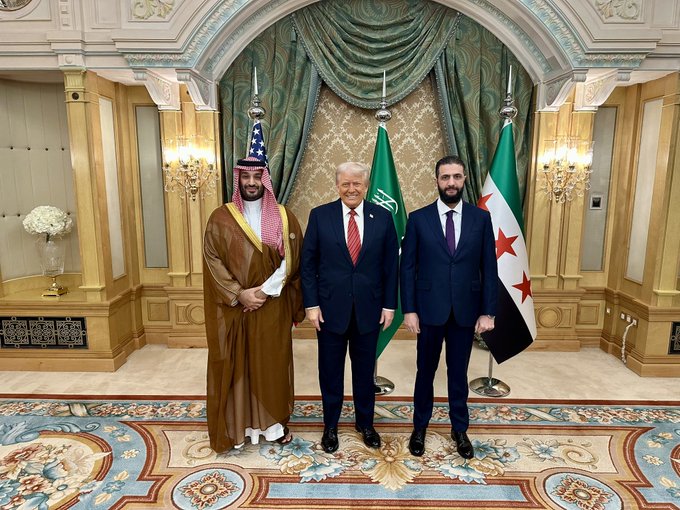On Wednesday, President Donald Trump met with interim Syrian President Ahmed al-Sharaa during a significant diplomatic visit to Saudi Arabia. The meeting was a critical moment in U.S.-Middle East relations, involving not only Trump and Sharaa but also Saudi Crown Prince Mohammed bin Salman, who attended in person, and Turkish President Recep Tayyip Erdogan, who joined the conversation by phone. The White House’s readout of the meeting highlighted the diplomatic discussions that focused on the future of Syria, regional stability, and opportunities for collaboration, particularly in the context of U.S. policies in the Middle East.
The meeting with Sharaa marked a pivotal moment in U.S. foreign policy towards Syria, a country ravaged by years of civil conflict. Since taking office in December, Sharaa, who assumed the presidency following the ousting of former President Bashar al-Assad by a coalition of rebel groups, has faced significant challenges in stabilizing the country. Trump’s remarks to Sharaa were notably encouraging, with the president emphasizing the “tremendous opportunity” Sharaa had to shape Syria’s future, especially following the lifting of U.S. sanctions. These sanctions had been a key component of the U.S. strategy to pressure Assad’s regime and its allies.
Trump urged Sharaa to seize the moment by normalizing relations with Israel, a move that has been part of the broader U.S.-Middle East strategy, particularly through the Abraham Accords. These agreements, which were brokered during Trump’s first term, established formal diplomatic relations between Israel and several Arab countries, including the UAE, Bahrain, Sudan, and Morocco. Trump stressed the importance of Syria taking steps towards peace and regional cooperation, specifically through the normalization of relations with Israel. This, according to the White House readout, was seen as a strategic move that could help stabilize the region and foster economic and political cooperation.
In addition to discussing relations with Israel, Trump urged Sharaa to eject all foreign terrorists from Syria, including Palestinian groups. This directive aligns with broader U.S. goals of combating terrorism in the region and preventing the resurgence of groups like ISIS. The situation in Syria has been complex, with multiple foreign actors involved, including Russia, Iran, and Turkey, each with their own interests in the region. Trump’s call for Sharaa to take responsibility for the detention centers holding ISIS fighters in northeastern Syria was another key point of the meeting. The U.S. has been heavily involved in the fight against ISIS, and securing the region’s future stability remains a top priority.
Sharaa responded by expressing his gratitude for the opportunity to meet with Trump and the other leaders. He acknowledged the significant opportunity presented by the departure of Iranian forces from Syria, which has been a crucial development in the ongoing conflict. Sharaa recognized the shared interests between the U.S. and Syria, particularly in combating terrorism and eliminating chemical weapons—a key concern in the Syrian conflict. Syria has faced significant international scrutiny over its use of chemical weapons during the civil war, and efforts to address this issue have been a major focus of international diplomatic efforts.
Sharaa also expressed his hope that Syria could serve as a “critical link” in facilitating trade between the East and the West. He invited American companies to invest in Syria’s oil and gas industries, signaling his desire to open up economic opportunities for foreign investors in the war-torn country. The invitation to American companies comes at a time when Syria is seeking to rebuild its economy and infrastructure, both of which have been severely damaged by years of conflict. Despite the challenges, Sharaa’s comments reflect a potential shift towards rebuilding Syria’s economy and fostering international trade relations, with the hope that economic growth could contribute to greater stability in the region.
In addition to discussions on Syria, the leaders also touched on broader regional issues, including the ongoing war in Ukraine and the conflict in Gaza. These discussions underscore the complex web of geopolitical interests that define the Middle East and beyond. The U.S. has been a key player in the Ukraine conflict, providing military and financial support to Ukraine in its struggle against Russia’s invasion. Trump’s engagement with Middle Eastern leaders on these issues indicates a recognition of the interconnectedness of global conflicts and the need for cooperation to address these challenges.
The meeting between Trump, Sharaa, and other leaders was also seen as a moment of diplomatic significance in the context of U.S. foreign policy in the Middle East. Trump has been a controversial figure in U.S. foreign policy, particularly regarding his approach to international relations and his stance on the Middle East. His engagement with Sharaa and the broader regional discussions reflect his continued focus on pursuing a foreign policy agenda that prioritizes economic development, regional cooperation, and the protection of U.S. interests.
In the aftermath of the meeting, White House Press Secretary Karoline Leavitt shared a photo on the social media platform X, showing Trump, Sharaa, and Crown Prince Mohammed bin Salman together. This image served as a visual representation of the diplomatic talks, highlighting the importance of the meeting and the cooperation between the U.S. and its allies in the region.
The meeting with Sharaa represents a significant step in the evolving dynamics of U.S.-Syria relations and the broader Middle East peace process. While challenges remain, particularly in terms of Syria’s political and economic recovery, the dialogue between the U.S., Syria, and other regional powers signals a potential opportunity for progress in addressing longstanding issues of regional stability, security, and cooperation.
Looking forward, it will be crucial to see how these diplomatic discussions translate into tangible actions and whether Sharaa’s leadership can successfully navigate the complex political landscape of Syria, balancing the interests of domestic factions and international stakeholders. The U.S. will likely continue to monitor developments in Syria closely, particularly in relation to its counterterrorism efforts, the normalization of relations with Israel, and Syria’s potential role in regional trade.
In conclusion, the meeting between President Trump and interim Syrian President Ahmed al-Sharaa, with the participation of Crown Prince Mohammed bin Salman and President Erdogan, marks a significant diplomatic moment in the ongoing efforts to stabilize Syria and foster cooperation in the Middle East. While the road ahead remains uncertain, this dialogue reflects a shared recognition of the need for engagement, peace, and development in the region. As the situation continues to unfold, it will be important to track the impact of these discussions and whether they can lead to meaningful progress in addressing Syria’s complex challenges and the broader geopolitical issues in the Middle East.


